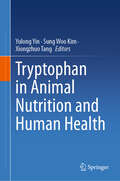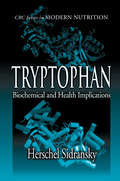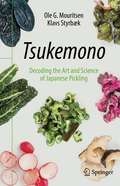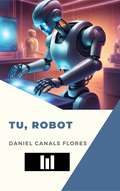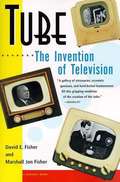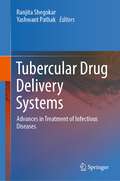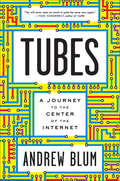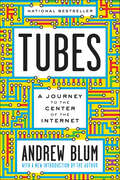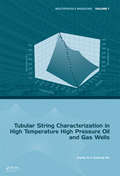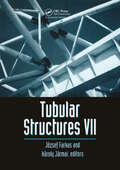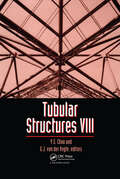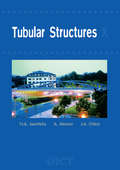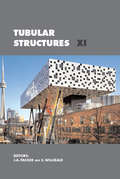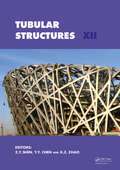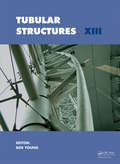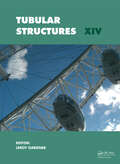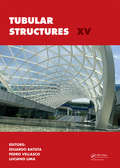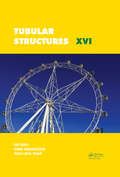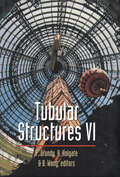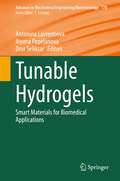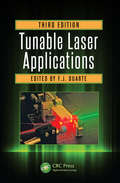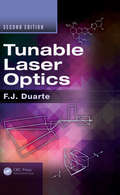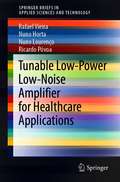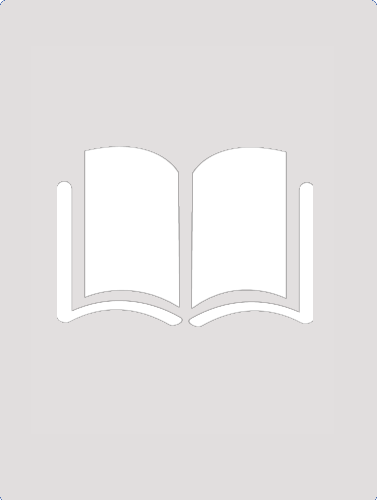- Table View
- List View
Tryptophan in Animal Nutrition and Human Health
by Yulong Yin Sung Woo Kim Xiongzhuo TangThis book integrates the research progress of Tryptophan (Trp) and its metabolites in animal nutrition and human health. It recapitulates the effects of Trp nutrition on the regulation of various physiological functions in farmed animals as well as the clinical connections between Trp metabolism and human diseases. Furthermore, this book includes detailed information about the manufacturing process of industrial Trp production and methodologies to study Trp metabolism. This book not only brings numerous benefits to academic communities worldwide but also provides practical values for industrial professionals/companies. Both of these two aspects will expand our understanding of how amino acid metabolism contributes to the maintenance of host health.
Tryptophan: Biochemical and Health Implications (Modern Nutrition)
by Herschel SidranskyHistorically, the amino acid tryptophan has been considered to play a role in cancer development and the aging process. In recent times, this nutrient has been associated with eosinophila myalgia syndrome - a new human disease that attacks the muscular system. This detailed book examines the implications of the large measure of fresh information ga
Tsukemono: Decoding the Art and Science of Japanese Pickling
by Ole G. Mouritsen Klavs StyrbækOne of the best-kept secrets of Japanese cuisine is a range of side dishes known as tsukemono (つけもの, 漬物). The word, pronounced ‘tskay-moh-noh,’ means ‘something that has been steeped or marinated’ (tsuke—steeped; mono—things). Although tsukemono are usually made from vegetables, some fruits, flowers, and a few rhizomes are also preserved this way; it is, therefore, more accurate to characterize them as ‘pickled foods.’ Their preparation makes use of one or more conservation techniques, involving ingredients such as salt, sugar, vinegar, alcohol, and herbs, in combination with methods including dehydration, marinating in salt and acidic liquids, fermentation, and curing. The process of making tsukemono amounts to more than just a simple way of preserving otherwise perishable fresh produce. Apart from its nutritional value, the dish stimulates the appetite, provides delicious taste sensations, and improves digestion, all while remaining an elegant study in simplicity and esthetic presentation. This book goes well beyond explaining the secrets of making crisp tsukemono. The authors discuss the cultural history and traditions associated with these pickled foods; provide recipes and outline techniques for preparing them at home with local ingredients; describe the healthful benefits and basic nutritional value to be found in the various types of pickles; and show how easy it is to serve them on a daily basis to stimulate the appetite or as condiments to accompany vegetable, fish, and meat dishes. The goal is to encourage the readers of this book to join us in a small culinary adventure that will allow us to expand and diversify our consumption of plant-based foods, which are so vital to our overall well-being. And along the way, there may be a few surprises.
Tu, robot
by Daniel Canals FloresTu, robot è un serio avvertimento per l'Umanità. Scrivendo questa storia un brivido mi ha attraversato l'anima: l'acronimo I.A. (Intelligenza Artificiale) corrisponde alle iniziali del genio indiscusso della robotica Isaac Asimov. Che il Maestro ne fosse a conoscenza? Questo libro vuole essere un tributo al suo lavoro ed alla sua inquietante visione futuristica. La quarta rivoluzione industriale e l’egoismo di pochi daranno origine al mostro che finirà per dominare l’Universo e distruggere la specie umana…
Tube: The Invention of Television
by Marshall Jon Fisher David E. FisherThe colorful, definitive story of the inventors of television, the race for patents, and the vicious courtroom battles for markets. You're on Jeopardy, the category is popular science, and the answer is "In 1927 he transmitted the first image via an all-electronic TV system." If you don't know the question, you're not alone. In the half century since its commercial unveiling, television has become the undisputed master of communications media, revolutionizing the way postwar generations have viewed the world. Yet few know how television was created, who created it, or how it actually works. Tube is a riveting tale of technological and commercial adventure. Here is the story not of one mad scientist working alone in a laboratory but of a group of brilliant minds—iconoclasts with motivations that ranged from the idealistic zeal of invention to pure greed, each keeping an eye on the others in the race for fortune and glory. Here, too, is the progress of an invention—from laboratory prototypes that drew public laughter to the legal warfare for control of what would become an enormous market power. With devilish character sketches, compelling stories, and engaging, accessible scientific explanations, authors David E. Fisher and Marshall Jon Fisher take us through the advent of "living color" and beyond, concluding with a glance to the future of the medium and the impact of recent digital technologies.
Tubercular Drug Delivery Systems: Advances in Treatment of Infectious Diseases
by Yashwant Pathak Ranjita ShegokarThe book targets new advances in areas of treatment and drug delivery sciences for tuberculosis. It covers advances in drug therapy and drug targeting that focus on innovative trend defining technologies and drug delivery platforms in the understanding of host-pathogens relationship for providing better therapy. A wide variety of novel and nano-formulations using promising technologies are being explored to deliver the drug via different administration routes. This book It addresses the gap between new approaches and old treatment modalities and how they are superior in pharmacological performance when tested in in-vitro and in-vivo. Audience from wide range group like from researchers to regulatory bodies can benefit from the compiled information to find out patient needs and current research advances in the field of tuberculosis research..
Tubes: A Journey to the Center of the Internet
by Andrew Blum“Andrew Blum plunges into the unseen but real ether of the Internet in a journey both compelling and profound….You will never open an email in quite the same way again.”—Tom Vanderbilt, New York Times bestselling author of TrafficWhen your Internet cable leaves your living room, where does it go? Almost everything about our day-to-day lives—and the broader scheme of human culture—can be found on the Internet. But what is it physically? And where is it really? Our mental map of the network is as blank as the map of the ocean that Columbus carried on his first Atlantic voyage. The Internet, its material nuts and bolts, is an unexplored territory. Until now.In Tubes, journalist Andrew Blum goes inside the Internet's physical infrastructure and flips on the lights, revealing an utterly fresh look at the online world we think we know. It is a shockingly tactile realm of unmarked compounds, populated by a special caste of engineer who pieces together our networks by hand; where glass fibers pulse with light and creaky telegraph buildings, tortuously rewired, become communication hubs once again. From the room in Los Angeles where the Internet first flickered to life to the caverns beneath Manhattan where new fiber-optic cable is buried; from the coast of Portugal, where a ten-thousand-mile undersea cable just two thumbs wide connects Europe and Africa, to the wilds of the Pacific Northwest, where Google, Microsoft, and Facebook have built monumental data centers—Blum chronicles the dramatic story of the Internet's development, explains how it all works, and takes the first-ever in-depth look inside its hidden monuments.This is a book about real places on the map: their sounds and smells, their storied pasts, their physical details, and the people who live there. For all the talk of the "placelessness" of our digital age, the Internet is as fixed in real, physical spaces as the railroad or telephone. You can map it and touch it, and you can visit it. Is the Internet in fact "a series of tubes" as Ted Stevens, the late senator from Alaska, once famously described it? How can we know the Internet's possibilities if we don't know its parts?Like Tracy Kidder's classic The Soul of a New Machine or Tom Vanderbilt's recent bestseller Traffic, Tubes combines on-the-ground reporting and lucid explanation into an engaging, mind-bending narrative to help us understand the physical world that underlies our digital lives.
Tubes: A Journey to the Center of the Internet
by Andrew BlumAn engaging, narrative tour behind the scenes of our everyday lives to see the dark beating heart of the Internet itself.We are all connected now. But connected to what, exactly? In Tubes, journalist Andrew Blum takes readers on a fascinating journey to find out.When former Senator Ted Stevens of Alaska famously described the Internet as “a series of tubes,” he seemed hopelessly, foolishly trapped in an old way of knowing the world. But he wasn’t wrong. After all, as Blum writes, the Internet exists: for all the talk of the “placelessness” of our digital age, the Internet is as fixed in real, physical places as any railroad or telephone ever was. It fills enormous buildings, converges in some places and avoids others, and it flows through tubes under ground, up in the air, and under the oceans all over the world. You can map it, you can smell it, and you can even visit it—and that’s just what Blum does in Tubes.From the room in Berkeley where the Internet flickered to life to the busiest streets in Manhattan as new fiber optic cable is laid down; from the coast of Portugal as a 10,000-mile undersea cable just two thumbs’ wide is laid down to connect Europe and West Africa to the wilds of the Pacific Northwest, where Google, Microsoft and Facebook have built monumental data centers—Blum visits them all to chronicle the dramatic story of the Internet’s development, explain how it all works, and capture the spirit of the place/Like Tracy Kidder’s classic The Soul of a New Machine or Tom Vanderbilt’s recent bestseller Traffic, Tubes combines deep reporting and lucid explanation into an engaging quest to understand the everyday world we live in.
Tubular String Characterization in High Temperature High Pressure Oil and Gas Wells (Multiphysics Modeling)
by Jiuping Xu Zezhong WuHigh temperature, high oil pressure, oil and gas well completion testing have always been a technical challenge and basic theoretical research is one of the key factors needed to ensure a successful completion test. The completion test basic theory includes: a stress analysis of the completion string, completion string buckling behavior, and temperature and pressure distribution prediction. The completion string is the main bearing and power transmission component for oil and gas well operations and production, and it is required to take on a combination of loads, which result in completion string deformation. Because of these complex relationships, completion string stress analysis has become increasingly more complicated.This book discusses the characters of tubular strings in HTHP (High Temperature - High Pressure) oil and gas wells. These characters include the mechanical behavior of tubular strings and the temperature and pressure variation of tubular strings in different conditions. Mathematical models are established for different conditions and solution existence and uniqueness of some models is discussed, providing algorithms corresponding to the different models. Numerical experiments are presented to verify the validity of models and the feasibility of algorithms, and the impact of the parameters of models for oil and gas wells is also discussed.This book is written for production and testing engineers to provide them with the tools to deal more effectively with the numerical decisions they have to take and for researchers and technicians in petroleum and gas testing and production engineering. Finally, it is also intended to serve as a reference book for mathematicians, college teachers and students.
Tubular Structures VII: Proceedings of the seventh international symposium, Miskolc, Hungary, 28-30 August 1996
by József Farkas; Károly JármaiThis volume contains 60 papers dealing with research results in the field of tubular structures. The following areas are covered: applications; static and fatigue behaviour of hollow section joints; beam-to-column connections; concrete-filled steel tubes; and optimum design.
Tubular Structures VIII
by Y.S.CHOO; G.J.VAN DER VEGTEFirst published in 1998. Looking at the architecture and engineering of tubular structures, and the behaviour of section joints, members and frames under different loads and conditions, this book provides a reference point for both civil and mechanical engineers.
Tubular Structures X: Proceedings of the 10th International Symposium, Madrid, Spain, 18-20 September 2003
by M.A. Jaurrieta, A. Alonso and J.A. ChicaThis volume contains the Kurobane lecture and proceedings of the Tenth International Symposium on Tubular Structures - ISTS10, held in Madrid, Spain, 18-20 September 2003. The ISTS10 provides a platform for the presentation and discussion of seventy-three lectures covering themes including: bridges; roofs; design aspects and case studies; static joint behaviour; fatigue; members; beam-column connections; finite element methods; concrete filled tubes; trusses and frames; cast nodes; and behaviour of tubular structures under fire. This book provides a useful reference work for architects, civil and mechanical engineers, designers, manufacturers and contractors involved with tubular structures.
Tubular Structures XI: 11th International Symposium and IIW International Conference on Tubular Structures
by J.A. PACKER & S. WILLIBALDThis topical book contains the latest scientific and engineering developments in the field of tubular steel structures, as presented at the "11th International Symposium and IIW International Conference on Tubular Structures". The International Symposium on Tubular Structures (ISTS) has a long-standing reputation for being the principal showcase for manufactured tubing and the prime international forum for discussion of research, developments and applications in this field. Various key and emerging subjects in the field of hollow structural sections are covered, such as: novel applications and case studies, static and fatigue behaviour of connections/joints, concrete-filled and composite tubular members, earthquake resistance, specification and code developments, material properties and structural reliability, impact resistance and brittle fracture, fire resistance, casting and fabrication innovations. Research and development issues presented in this book are applicable to buildings, bridges, offshore structures, entertainment rides, cranes, towers and various mechanical and agricultural equipment. This book is thus a pertinent reference source for architects, civil and mechanical engineers, designers, steel fabricators and contractors, manufacturers of hollow sections or related construction products, trade associations involved with tubing, owners or developers of tubular structures, steel specification committees, academics and research students. The conference presentations herein include two keynote lectures (the International Institute of Welding Houdremont Lecture and the ISTS Kurobane Lecture), plus finalists in the CIDECT Student Papers Competition. The 11th International Symposium and IIW International Conference on Tubular Structures – ISTS11 – took place in Québec City, Canada from August 31 to September 2, 2006.
Tubular Structures XII: Proceedings of Tubular Structures XII, Shanghai, China, 8-10 October 2008
by Z.Y. Shen, Y.Y. Chen & X.Z. ZhaoPresentation of the latest scientific and engineering developments in the field of tubular steel structures. Covers key and emerging subjects of hollow structural sections, such as: static and fatigue behaviour of connections/joints, concrete filled hollow sections and composite tubular members, offshore structures, earthquake resistance.
Tubular Structures XIII
by Ben YoungTubular Structures XIII contains the latest scientific and engineering developments in the field of tubular steel structures, as presented at the 13th International Symposium on Tubular Structures (ISTS13), Hong Kong, 15 - 17 December 2010. The International Symposium on Tubular Structures (ISTS) has a longstanding reputation for being the pri
Tubular Structures XIV
by Leroy GardnerTubular Structures XIV contains the latest scientific and engineering developments in the field of tubular steel structures, as presented at the 14th International Symposium on Tubular Structures (ISTS14, Imperial College London, UK, 12-14 September 2012). The International Symposium on Tubular Structures (ISTS) has a long-standing reputation for b
Tubular Structures XV: Proceedings of the 15th International Symposium on Tubular Structures, Rio de Janeiro, Brazil, 27-29 May 2015
by Pedro Vellasco Eduardo Batista Luciano LimaTubular Structures XV contains the latest scientific and engineering developments in the field of tubular structures, as presented at the 15th International Symposium on Tubular Structures (ISTS15, Rio de Janeiro, Brazil, 27-29 May 2015). The International Symposium on Tubular Structures (ISTS) has a long-standing reputation for being the principal
Tubular Structures XVI: Proceedings of the 16th International Symposium for Tubular Structures (ISTS 2017, 4-6 December 2017, Melbourne, Australia)
by Amin Heidarpour & Xiao-Ling ZhaoTubular Structures XVI contains the latest scientific and engineering developments in the field of tubular steel structures, as presented at the 16th International Symposium on Tubular Structures (ISTS16, Melbourne, Australia, 4-6 December 2017). The International Symposium on Tubular Structures (ISTS) has a long-standing reputation for being the principal showcase for manufactured tubing and the prime international forum for presentation and discussion of research, developments and applications in this field. Various key and emerging subjects in the field of hollow structural sections are covered, such as: special applications and case studies, static and fatigue behaviour of connections/joints, concrete-filled and composite tubular members and offshore structures, earthquake and dynamic resistance, specification and standard developments, material properties and section forming, stainless and high-strength steel structures, fire, impact and blast response. Research and development issues presented in this topical book are applicable to buildings, bridges, offshore structures, cranes, trusses and towers. Tubular Structures XVI is thus a pertinent reference source for architects, civil and mechanical engineers, designers, steel fabricators and contractors, manufacturers of hollow sections or related construction products, trade associations involved with tubing, owners or developers of tubular structures, steel specification committees, academics and research students all around the world.
Tubular Structures: Sixth International Symposium on Tubular Structures, Melbourne, Australia, 1994 Proceedings, Melbourne, Australia
by PAUL GRUNDY; ALAN HOLGATE; BILL WONGTubular structures remain a source of architectural inspiration and practical solutions to difficult performance specifications. New developments are covered in this text, which contains papers on design innovations and applications presented at an international symposium held in Australia in 1994.
Tunable Hydrogels: Smart Materials for Biomedical Applications (Advances in Biochemical Engineering/Biotechnology #178)
by Antonina Lavrentieva Iliyana Pepelanova Dror SeliktarThis book reviews the current knowledge on tunable hydrogels, including the range of different materials and applications, as well as the existing challenges and limitations in the field. It covers various aspects of the material design, particularly highlighting biological responsiveness, degradability and responsiveness to external stimuli. In this book, readers will discover original research data and state-of-the-art reviews in the area of hydrogel technology, with a specific focus on biotechnology and medicine. Written by leading experts, the contributions outline strategies for designing tunable hydrogels and offer a detailed evaluation of the physical and synthetic methods currently employed to achieve specific hydrogel properties and responsiveness. This highly informative book provides important theoretical and practical insights for scholars and researchers working with hydrogels for biomedical and biotechnological applications.
Tunable Laser Applications (Optical Science And Engineering Ser.)
by F. J. DuarteBroadly tunable lasers continue to have a tremendous impact in many and diverse fields of science and technology. From a renaissance in laser spectroscopy to Bose-Einstein condensation, the one nexus is the tunable laser. Tunable Laser Applications describes the physics and architectures of widely applied tunable laser sources. Fully updated and ex
Tunable Laser Optics (Optics And Photonics Ser.)
by F. J. DuarteBroadly tunable lasers have had, and continue to have, an enormous impact in many and diverse fields of science and technology. From a renaissance in spectroscopy to laser guide stars and laser cooling, the nexus is the tunable laser. Tunable Laser Optics offers a transparent and comprehensive treatment of the physics of tunable laser optics based on a detailed description of first principles. Authored by a leading expert in the field, the book covers the optics and optical principles needed to build lasers, the optics instrumentation necessary to characterize laser emission, and laser-based optical instrumentation, addressing key topics such as Dirac’s notation, the interferometric equation, the uncertainty principle, pulse compression, and tunable narrow-linewidth lasers. This revised, expanded, and improved Second Edition: Contains new and additional material on tunable lasers and quantum optics Explains the first principles of tunable laser optics in a clear and concise manner Presents an explicit exposition of the relevant theory, without the use of short cuts Employs numerous examples, case studies, and figures to illustrate important concepts Includes carefully designed problems of direct practical significance to stimulate application Emphasizing the utilitarian aspects of the optics and theory, Tunable Laser Optics, Second Edition provides valuable insight into the optics and the trade-offs involved in the design and construction of tunable lasers and optical devices. It makes an ideal textbook for advanced undergraduate-level and graduate-level optics courses for physics and engineering students, as well as a handy reference for researchers and experimentalists.
Tunable Low-Power Low-Noise Amplifier for Healthcare Applications (SpringerBriefs in Applied Sciences and Technology)
by Nuno Horta Nuno Lourenço Rafael Vieira Ricardo PóvoaThis book consists of the research, design and implementation, from sizing to layout with parasitic extraction and yield estimation, of a low-power, low-noise amplifier for biomedical and healthcare applications of bio-potential signals, particularly focusing on the electromyography and electrooculography. These signals usually operate in different broadbands, yet follow an impulse-shape transmission, hence being suitable to be applied and detected by the same receiver.
Tunable Micro-optics
by Hans Zappe Claudia DuppéPresenting state-of-the-art research into the dynamic field of tunable micro-optics, this is the first book to provide a comprehensive survey covering a varied range of topics including novel materials, actuation concepts and new imaging systems in optics. Internationally renowned researchers present a diverse range of chapters on cutting-edge materials, devices and subsystems, including soft matter, artificial muscles, tunable lenses and apertures, photonic crystals, and complete tunable imagers. Special contributions also provide in-depth treatment of micro-optical characterisation, scanners, and the use of natural eye models as inspiration for new concepts in advanced optics. With applications extending from medical diagnosis to fibre telecommunications, Tunable Micro-optics equips readers with a solid understanding of the broader technical context through its interdisciplinary approach to the realisation of new types of optical systems. This is an essential resource for engineers in industry and academia, and advanced students working on optical systems design.
Tunbridge World's Fair, The
by Euclid FarnhamSince its opening in 1867, the Tunbridge World's Fair has drawn hundreds of thousands of people to its one-of-a-kind event, showcasing the best of regional agriculture and entertainment. The fair, originally intended to determine who owned the fastest horse or best-looking cow, began as an improvised event in farmer Elisha Lougee's North Tunbridge pasture and quickly grew into the complex it is today, with well-developed fairgrounds centered around a half-mile racetrack. During the 1929 fair, the Log Cabin Museum was opened with many local residents reenacting the skills of the early settlers. Over the generations, the fair has matured into the best of its kind in northern New England.
